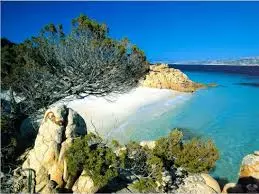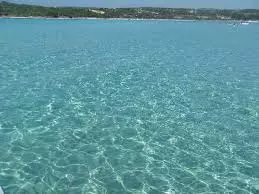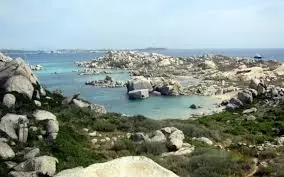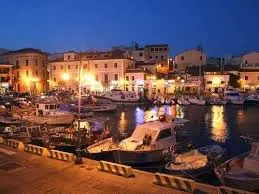South Corsica

1 • Santa Maria
From Cala dei Sardi, you will head towards the island of Santa Maria, located to the east of Razzoli and northeast of Budelli. It is the flattest compared to the other islands, covered with particularly lush vegetation. The coastline is very rugged, and it is the only island with settlements, concentrated around the bay of Cala Santa Maria and along the coast facing La Maddalena. The beach is wide, with fine white sand stretching for 200 meters, one of the largest in the entire archipelago. The seabed gradually deepens from the shore to the open sea, forming a natural pool of great charm. Near the bay, behind it, lies a body of water known as "Il Palude," a brackish water lagoon frequented by numerous bird species.
1 • Santa Maria

From Cala dei Sardi, you will head towards the island of Santa Maria, located to the east of Razzoli and northeast of Budelli. It is the flattest compared to the other islands, covered with particularly lush vegetation. The coastline is very rugged, and it is the only island with settlements, concentrated around the bay of Cala Santa Maria and along the coast facing La Maddalena. The beach is wide, with fine white sand stretching for 200 meters, one of the largest in the entire archipelago. The seabed gradually deepens from the shore to the open sea, forming a natural pool of great charm. Near the bay, behind it, lies a body of water known as "Il Palude," a brackish water lagoon frequented by numerous bird species.

2 • Rondinara
Enclosed between two headlands covered in Mediterranean scrub, this small bay is one of the most photographed spots in Corsica. With white sand and crystal-clear turquoise waters, the bay has several beaches within it. On the largest beach, which is also accessible by road, there is a single restaurant available that serves typical French breakfasts with fragrant croissants.
2 • Rondinara

Enclosed between two headlands covered in Mediterranean scrub, this small bay is one of the most photographed spots in Corsica. With white sand and crystal-clear turquoise waters, the bay has several beaches within it. On the largest beach, which is also accessible by road, there is a single restaurant available that serves typical French breakfasts with fragrant croissants.

3 • Isola Piana
A stop at Isola Piana is a must, just half an hour by boat from Bonifacio towards the Maddalena Archipelago. It features a pedestrian passage in the middle of the sea, and at low tide, you can reach Punta Sperone on foot, right below the golf course. The unique colors of the sea are not to be missed.
3 • Isola Piana

A stop at Isola Piana is a must, just half an hour by boat from Bonifacio towards the Maddalena Archipelago. It features a pedestrian passage in the middle of the sea, and at low tide, you can reach Punta Sperone on foot, right below the golf course. The unique colors of the sea are not to be missed.

4 • Bonifacio
The Gods could only gift Corsica, at its far southern tip, with a unique place. It takes the form of a white ship proudly setting out to conquer the open sea: Bonifacio!
The charm of this old town, dazzling in its whiteness and scattered with attractive old streets climbing up to the summit of the Citadel, is irresistible. It is bordered by inlets from which you can admire the islands of Lavezzi and Cavallo, and Sardinia.
Arriving by boat is particularly captivating. From afar, the entrance to the harbor looks like a crack in the white limestone rock, and as you enter the fjord, you don't immediately see the town. First, there’s a bend with small bays where some boats anchor when the port is full. Once past the bend, the view of Bonifacio opens up: from the docks, where nautical activities take place, to the top of the citadel, teeming with tourists and locals. Remember, you’re in France! Already on the harbor, you’ll find the classic “baguettes,” and if you climb the streets leading to the “belvedere” viewpoints, you’ll come across various “creperies.”
It’s worth climbing all the way to the top, where you can admire the stretch of sea that separates Corsica from Sardinia. On windy days, the view is breathtaking, and the stormy sea evokes Kantian memories.
4 • Bonifacio

The Gods could only gift Corsica, at its far southern tip, with a unique place. It takes the form of a white ship proudly setting out to conquer the open sea: Bonifacio!
The charm of this old town, dazzling in its whiteness and scattered with attractive old streets climbing up to the summit of the Citadel, is irresistible. It is bordered by inlets from which you can admire the islands of Lavezzi and Cavallo, and Sardinia.
Arriving by boat is particularly captivating. From afar, the entrance to the harbor looks like a crack in the white limestone rock, and as you enter the fjord, you don't immediately see the town. First, there’s a bend with small bays where some boats anchor when the port is full. Once past the bend, the view of Bonifacio opens up: from the docks, where nautical activities take place, to the top of the citadel, teeming with tourists and locals. Remember, you’re in France! Already on the harbor, you’ll find the classic “baguettes,” and if you climb the streets leading to the “belvedere” viewpoints, you’ll come across various “creperies.”
It’s worth climbing all the way to the top, where you can admire the stretch of sea that separates Corsica from Sardinia. On windy days, the view is breathtaking, and the stormy sea evokes Kantian memories.

5 • Lavezzi
Upon arriving at Lavezzi, paying attention to the shallow waters and emerging rocks, you will be captivated by the island's extraordinary beauty, which draws many tourists, aided by its proximity to the main towns on the larger islands. Its territory is part of the Bonifacio Straits Nature Reserve, which, together with the National Park of the La Maddalena Archipelago, will form the International Park of the Bonifacio Straits.
Very close to the island of Cavallo, it shares with it a narrow rocky passage, which in the past was the site of numerous shipwrecks, one of which, in 1855, caused around 700 deaths in the sinking of the French frigate Sémillante. The victims are buried in two small cemeteries on the island.
5 • Lavezzi

Upon arriving at Lavezzi, paying attention to the shallow waters and emerging rocks, you will be captivated by the island's extraordinary beauty, which draws many tourists, aided by its proximity to the main towns on the larger islands. Its territory is part of the Bonifacio Straits Nature Reserve, which, together with the National Park of the La Maddalena Archipelago, will form the International Park of the Bonifacio Straits.
Very close to the island of Cavallo, it shares with it a narrow rocky passage, which in the past was the site of numerous shipwrecks, one of which, in 1855, caused around 700 deaths in the sinking of the French frigate Sémillante. The victims are buried in two small cemeteries on the island.

6 • La Maddalena
La Maddalena, the capital of the archipelago of the same name, is a small town crisscrossed by "carrugi," the Genoese name for its narrow alleys, which climb the hill above Cala Gavetta, the historic port around which the entire town developed. In the town, you can find shops of all kinds, as well as restaurants and pizzerias. If you want to spend a night here, it's best to book in advance, especially in July and August. The island is dotted with numerous beaches: Spalmatore, to the northeast, where you can moor, and Cala Francese, a cove sheltered from the wind, located just behind Cala Gavetta. Another small port is Porto Massimo, in the northern part of the island.
6 • La Maddalena

La Maddalena, the capital of the archipelago of the same name, is a small town crisscrossed by "carrugi," the Genoese name for its narrow alleys, which climb the hill above Cala Gavetta, the historic port around which the entire town developed. In the town, you can find shops of all kinds, as well as restaurants and pizzerias. If you want to spend a night here, it's best to book in advance, especially in July and August. The island is dotted with numerous beaches: Spalmatore, to the northeast, where you can moor, and Cala Francese, a cove sheltered from the wind, located just behind Cala Gavetta. Another small port is Porto Massimo, in the northern part of the island.
